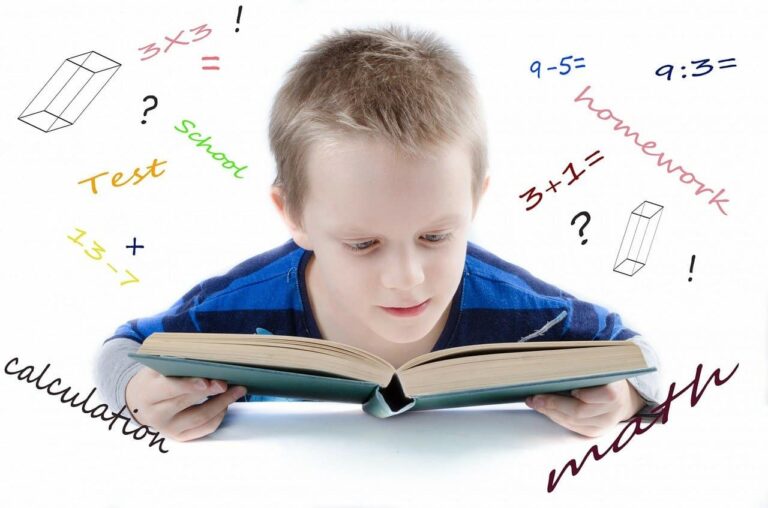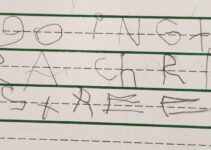Are you bad at math? Are your children bad at math? Many people express a dislike of math, saying that it is difficult or boring.
There is a difference, though, between being “bad at math” and being unable to do math. The latter may be a condition that is called dyscalculia. This learning disability affects a person’s ability to complete math related activities for a lifetime.
Evidence shows that dyscalculia may also be at least partly genetic. This guide will explain what dyscalculia is, how it affects the brain, and what can be done to help your child with math in school.
Table of Contents
What is Dyscalculia?
Dyscalculia is a learning disorder where children have difficulty acquiring the mental processing skills required to complete math calculations.
They also display difficulty comprehending math concepts, including understanding numbers and math symbols, sequencing, grouping, counting and organizing. People with dyscalculia may also have difficulty with functional skills related to math, such as telling time or managing money.
What Are the Symptoms of Dyscalculia?
Dyscalculia affects a person for a lifetime. The two primary symptoms of the condition, which persist from childhood into adulthood, are:
- Using inefficient and immature counting methods to solve simple math problems, such as counting on fingers
- An ongoing inability to retrieve math facts from memory
More specific symptoms of dyscalculia are partly dependent on a person’s age. Here are some symptoms of dyscalculia by age:
- Preschool (Age 2-5):
- Difficulty remembering number names and learning to count.
- Trouble recognizing patterns.
- Difficulty knowing that a number represents a group of objects, i.e. the number 3 represents a group of 3 cookies.
- Difficulty grouping objects that are the same.
- Trouble understanding general concepts of quantity, such as more, less, etc.
- Problems understanding how to sequence events.
- Lack of understanding of general time concepts, such as morning, afternoon, today, tomorrow, days of the week, months of the year.
- Elementary School Age (Age 5-12):
- Continued problems identifying and remembering number names.
- Problems identifying number words.
- Trouble writing numbers. May reverse numbers.
- Difficulty remembering number values and how numbers relate to each other.
- Lack of development of the “mental number line”. May depend on physical methods of counting, such as counting on fingers, counting small objects, using touch math techniques, and so on.
- Difficulty remembering the basic math functions of adding, subtracting, multiplying and dividing.
- Problems naming math functions.
- Difficulty remembering and sequencing the steps involved in completing basic math calculations.
- Trouble understanding and completing word problems.
- Difficulty learning to tell time.
- Problems identifying money and remembering monetary values.
- Trouble understanding fractions.
- Dislike of math, avoidance of math homework
- Middle/High School Age (Age 13-18):
- Continued struggles with all math concepts typically learned in elementary school.
- Difficulty with time management and prioritizing tasks.
- Trouble understanding concepts of money quantity, i.e. how much money is enough for a purchase?
- Chronically low grades in math.
- Avoidance of math, low self-concept regarding math abilities.
- Gravitating toward adaptive math techniques when offered, i.e. use of calculators and math apps.
- Adulthood (Age 18+):
- Continued difficulty with all math concepts and functions.
- Trouble managing bank accounts and paying bills.
- Continued difficulty with time management.
- Gravitation toward careers that do not require a lot of math.
- Reliance on adaptive math techniques and devices, such as calculators, banking apps, electronic organizers.
What Causes Dyscalculia?
Dyscalculia as a condition has been repeatedly overshadowed by other neurological conditions and learning disabilities, such as dyslexia, attention deficit hyperactivity disorder, and delays in language development.
In fact, even though dyscalculia is estimated to occur in about 5% of students in the United States, dyslexia research appears in scientific journals close to 14 times more frequently than dyscalculia research (Ansari, 2019).
Researchers are now beginning to understand what causes dyscalculia. MRI studies have shown that math functions are centered in the parietal lobes of the brain. Children with dyscalculia show weaker activation signals in this part of the brain when completing math calculations.
In addition, these children showed weaker signals in the frontal lobes that handle working memory and executive functions that relate to organization (Von Aster, 2007).
This means that, in addition to difficulty completing math, children with dyscalculia may also have difficulty organizing their day, remembering materials, and completing other tasks that require executive functions.
How is Dyscalculia Different from Dyslexia?
The neurological patterns found in dyscalculia are similar to those found in dyslexia. A recent study compared MRI results of children with dyscalculia to children with dyslexia and children without learning disabilities. MRI scans were taken while the children performed math problems in a variety of formats.
While the children performed differently on the problems depending on the type of disability, the MRI scans of both the children with dyscalculia and the children with dyslexia showed very similar levels of activation of the parietal and frontal lobes. Both were weaker when compared to children without learning disabilities (Peters, et. al. 2018).
Even though patterns of brain activation are similar, the problems associated with dyscalculia and dyslexia are quite different. People with dyscalculia struggle with remembering math facts and completing math problems, while people with dyslexia struggle with reading due to difficulties decoding letters and words.
Both are included under the category Specific Learning Disability (SLD) in the Diagnostic and Statistical Manual of Mental Disorders, 5th edition (DSM-5). In school, if your child is identified as having dyscalculia, he or she receives services under the diagnosis of SLD. This is also true for children who have dyslexia.
How Common is Dyscalculia and Does it Run in Families?
In the countries that have studied the prevalence of dyscalculia, including the United States, rates of dyscalculia in primary school age children consistently runs at about 5% (Kaufman and von Aster, 2012). Evidence suggests that there is a genetic component to dyscalculia and that the condition runs in families.
A 2001 study of children with dyscalculia, their siblings and their parents found that roughly half of the children’s relatives had dyscalculia, which was close to tenfold higher than what the researchers expected to find in the general population (Shalev, et. al. 2001).
Other literature on the subject supports this finding, but also states that other factors contribute to the presence of dyscalculia, including other neurological conditions, environment, and the presence of math anxiety.
Is Dyscalculia Associated With Other Conditions?
Dyscalculia is frequently associated with other conditions. About two thirds of children who have dyscalculia also have another condition. In particular, dyscalculia may occur simultaneously with dyslexia.
A Dutch study of 799 school age children found a rate of co-occurrence of reading and math disabilities of 7.6%, which was higher than what the researchers anticipated (Dirks, et. al. 2008).
Some of the other conditions that may occur together with dyscalculia include:
- Attention Deficit Hyperactivity Disorder (ADHD)
- Speech and Language Delays
- Dysgraphia
- Autism
- Turner Syndrome
- Fetal Alcohol Syndrome
- Traumatic Brain Injury
Who Can Diagnose Dyscalculia and How is it Diagnosed?
Since dyscalculia is a condition that often occurs with other conditions, diagnosis is best done by a clinician that can test for many different diagnoses. A neuropsychologist can administer the types of tests required to identify dyscalculia, as well as other conditions that may also be present, such as dyslexia or ADHD.
Testing of this nature is typically done during an office visit. If your child requires testing for more than one condition, testing may require two or more visits, as this type of can take up to 8 hours to complete.
Special education staff at your child’s school can also help to identify specific learning disabilities in the area of math. Special education teachers and school psychologists can administer testing that is more specific to math skills and the brain processes that are required for math.
If your child has already been diagnosed with other conditions such as ADHD or if he is only displaying symptoms of dyscalculia, testing at school may be sufficient to identify the problem.
The tests used to diagnose dyscalculia assess the following skills:
- Computation – the ability to correctly complete math calculations.
- Math Fluency – the ability to quickly recall math facts, i.e. multiplication rules.
- Mental Computation – the ability to complete math calculations “in your head”.
- Quantitative Reasoning – the ability to understand quantities in relation to each other and to solve word problems (Kelly, 2019).
Will My Child Outgrow Dyscalculia?
Unfortunately, children do not outgrow dyscalculia. Since there is a genetic link involved in this condition and it sometimes runs in families, the evidence suggests that the underlying cause of dyscalculia is due to the way the brain is formed and this is not something that can be cured or changed.
This does not mean that your child will never be able to do math, but instead means that they will need to do math differently than other children.
How Will Dyscalculia Affect My Child’s Education?
Children with dyscalculia will struggle in the area of math throughout their education. If a child does not have any other conditions, they should perform similarly to other children in other subject areas, such as reading and writing. Children who have other conditions along with dyscalculia will struggle in multiple subjects.
These children will most likely require special education services to be able to learn the skills they need to advance in school.
The good news is that children with dyscalculia now have many resources available to them that were not available in the past. Through special education, children have access to specialized instruction, adaptive tools and methods, and assistive technology.
In the United States, these resources are all provided to children to assist with math disabilities in public schools through an Individualized Education Program (IEP).
If your child attends private school or is home schooled, an IEP is not required by federal law. Check your state’s regulations regarding the provision of special education services to children who do not attend public school.
How is Dyscalculia Treated?
Children with dyscalculia struggle with learning math concepts through traditional teaching methods, so they require alternate teaching techniques to help them remember and use math. Here are some of the methods used to teach math to children with dyscalculia:
Multisensory Teaching Techniques
This method of teaching engages multiple senses to help children learn and use math. The senses of vision, hearing and touch are typically engaged when using these teaching methods. Some examples are:
- Touch Math – this technique allows children to use dots placed in strategic spots on numbers to help them learn the quantity the number represents. Children touch the dots to help them count to that number, as well as to add and subtract that number from other numbers.
- Multisensory number cards – number cards that are colorful and have textures added, such as bumps, gel spikes, or sand assist young children in learning to form and identity of individual numbers.
- Math songs – using songs to memorize math facts can help children with dyscalculia to recall facts later by singing them.
- Manipulatives – this technique allows children to use counting blocks, counting sticks, or other small objects to represent quantities when learning number concepts, math facts, and completing math calculations.
Adaptations
When children cannot remember number sequences or math facts, they may use visual charts and guides to assist them with calculations. They tools may include:
- number lines
- multiplication and division tables
- fraction charts
- ordinals charts (number place, such as 10s, 100s, and so on)
- money identification and values charts
- basic calculators
Assistive Technology
This includes special devices, software, and apps that can assist children in completing math calculations. Assistive technology is especially helpful as children progress into higher grades. Adolescents and adults may continue to use assistive technology in high school, college, and beyond. Examples of assistive technology for dyscalculia include:
- Talking calculators – this type of calculator allows the person to hear the numbers as they press the keys as well as seeing the numbers on the screen.
- Large button calculators – these calculators are larger than normal and provide enlarged numbers for easier number recognition. Some large button calculators also incorporate a talking function.
- Graph or grid paper – this may not seem like technology, since it’s just paper, but the grid lines on graph paper help children with dyscalculia line up math problems correctly when completing calculations.
- Smart pens – a smart pen uses a tiny camera to capture the strokes used when writing. Children who have difficulty writing numbers legibly may be able to use a smart pen to take notes and complete calculations during math class so that they do not fall behind during lessons. They can later upload the information they wrote with the smart pen to a device to edit their work using a keyboard or voice typing.
- Math software and apps – there are many different types of math apps available for computers, tablets, and smart phones that allow people to learn math functions and complete math calculations without having to remember math facts. Software and apps are available for all platforms, including Google, Windows and iOS (Apple). A few examples include:
- Electronic math worksheets – this type of app allows the user to complete math problems on a device screen. This helps the user to align and organize problems while completing them, sort of like virtual graph paper. These apps may also include speech to text functions, where the child can speak the math problem rather than typing it, as well as text to speech, where the child can listen to the math problem after completing it to check for errors. An example of this type of app is MathTalk.
- Digital math apps – these apps are comprehensive and allow children to digitally construct and solve math problems using built-in assistive functions. EquateIO is an example of this type of app.
How Can I Help My Child at Home?
Helping your child to complete math homework when your child had dyscalculia requires patience and an understanding of the condition. It is important for parents, caregivers, and family members to understand that children with dyscalculia are going to have a difficult time completing math homework in the same way that other children do.
Children with dyscalculia may develop math anxiety when they are pushed to complete math homework without using tools or within a specific time frame. This will cause them to begin to avoid math or even fear it. Here are some guidelines to follow when helping your child with dyscalculia to complete math homework:
Follow the Teacher’s Recommendations
Your child with dyscalculia will be learning math using specific teaching methods and adaptations. Your child’s teacher will have recommendations regarding how your child completes math homework or if he completes math homework at all. It is important that you as a parent follow these recommendations.
Do not expect your son who has dyscalculia to complete his math homework just like his brother who does not have dyscalculia. Allow your child to complete his homework in the way his teacher has taught him to do it.
Make sure you communicate this to anyone else who might be supervising your children’s homework, including siblings, relatives, and caregivers.
Support Adapted Assignments
In my years of working with children who have special education needs, I have seen many parents insist that their children complete the same homework as their peers. This often creates anxiety on the part of the child and causes them to fall further behind than those who are allowed to complete adapted assignments.
Your child’s teacher may assign your child fewer math problems to complete or may require alternate assignments that involve multisensory or real-life elements. It is important that you support these adapted assignments and help your child to complete them, even if she is not doing the same homework as her classmates.
Provide Resources
Due to the nature of dyscalculia, your child will most likely need to use adaptations and assistive technology to complete math assignments. Make sure that you provide access to these adaptations to help with math homework.
You can consult with your child’s special education teacher regarding what resources your child will need access to at home. Some school districts may loan out these items during the school year or may provide online access to school purchased assistive technology apps.
Check your school district’s policies regarding access to required assistive technology.
Have Patience
Your child with dyscalculia may avoid math like the plague. It is understandable, since subjects that are difficult are not fun and may create anxiety. Have patience when your child needs to complete a math assignment at home.
He may need to take frequent breaks, have a snack available, or have you check his work as he completes it. Be available to your child to provide assistance and emotional support during math activities.
Help Your Child to Understand Why Math is Important
You may have heard “why do I need to do this?” many times. You can help your child to learn why by including her in daily activities where you need to use math.
Reading and following a recipe, counting change at the store, figuring out how much time a task will take, or using a map app to determine how long it will take to go somewhere are all examples of how you can involve your child in daily math activities.
If your child understands how adults use math and why math is important, it may help motivate her to put extra effort into her math work at school.
Resources for Parents
The following resources will provide you with information, ideas and support regarding your child with dyscalculia:
Learning Disabilities Association of America – information and resources regarding a wide variety of learning disorders, including dyscalculia.
LD Online – while primarily a resource for teachers, this website offers parents insight into teaching strategies for learning disabilities, including dyscalculia. The site has a specific page for dyscalculia related links.
Dyscalculia.org– this website is all about dyscalculia and includes an abundance of articles, links, and resources.
Math Geek Mama – parents can find fun math activities and information on how to make math painless here. A section on dyscalculia is included.
It is important to understand the difference between “bad at math” and dyscalculia. With the above recommendations and resources, children with dyscalculia should have the resources they need to succeed in school. If you suspect that your child has dyscalculia, talk to your child’s teacher as soon as possible.
References
- Kaufmann L, von Aster M. The diagnosis and management of dyscalculia. Deutsches Ӓrzteblatt Int. 2012;109:767–778. Retrieved November 16, 2019.
- Ansari, D. (2019, April 19). Developmental Dyscalculia: A New Understanding of Early Warning Signs. Retrieved November 23, 2019.
- Von Aster, M. G., & Shalev, R. S. (2007, October 26). Number development and developmental dyscalculia. Retrieved November 23, 2019.
- Peters, Lien, et al. “Dyscalculia and Dyslexia: Different Behavioral, Yet Similar Brain Activity Profiles during Arithmetic.” NeuroImage: Clinical, Elsevier, 4 Mar. 2018.
- Shalev, R S, et al. “Developmental Dyscalculia Is a Familial Learning Disability.” Journal of Learning Disabilities, U.S. National Library of Medicine, 2001.
- Dirks, Evelien, et. al. (2008, 1 September). Prevalence of combined reading and arithmetic disabilities. Retrieved November 27, 2019.
- Kelly, K. (2019, October 4). Types of Tests for Dyscalculia. Retrieved November 27, 2019.




